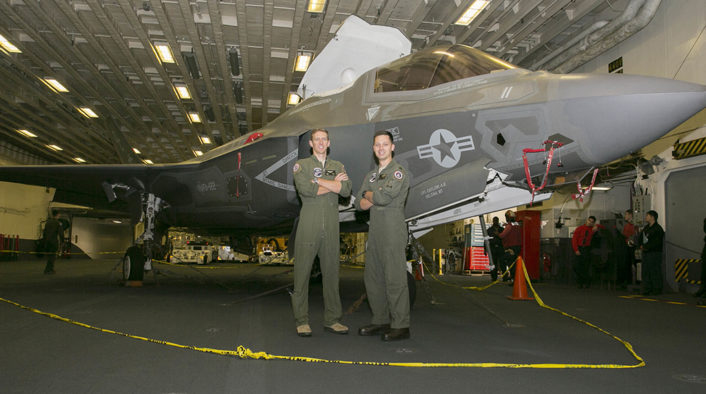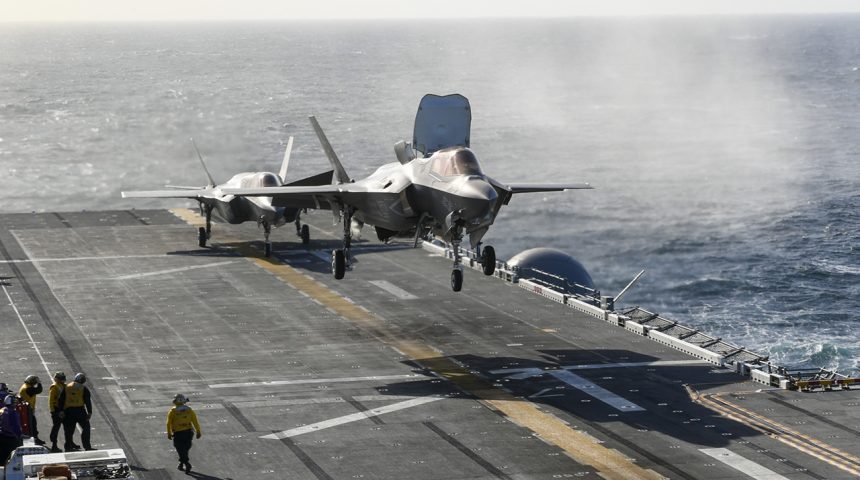U.S. Air Force Capt. Spencer G. Weide and Capt. Justin J. Newman are the first USAF operational pilots to fly the Lightning II aboard an amphibious assault ship.
While not operating the STOVL (Short Take Off Vertical Landing) variant of the Joint Strike Fighter, the U.S. Air Force got a taste of F-35B Lightning II‘s shipborne operations thanks to two operational pilots flying with the U.S. Marine Corps Marine Fighter Attack Squadron 122 (VMFA-122) out of Marine Air Corps Station Yuma, Arizona.
Capt. Spencer G. Weide and Capt. Justin J. Newman, were the first operational USAF pilots to fly the F-35B aboard USS America (LHA 6) as part of an integrated training exercise in the Eastern Pacific on Sept. 27, 2019.
13 F-35Bs assigned to VMGA 122, 3rd Marine Aircraft Wing, I Maritime Expeditionary Force are currently aboard the amphibious assault ship in what is the largest deployment of Lightning II at sea.
“This was the deployment of the largest number of F-35s ever put to sea, and for two weeks we put sortie rates to the test, deck cycles to the test, and multi-ship control to the test, all while stressing the communication links and tactics that will make us successful in any combat environment, anywhere in the world, as a joint Navy-Marine Corps team,” said Lt. Col. John Dirk, commanding officer, VMFA 122, in a Navy public release.
“The training went exceedingly well. We were able to sustain a high sortie rate, with a high condition of readiness, while interoperating with multiple ships and aircraft across a range of mission sets,” said Lt. Col. Dirk. “To fight together we have to train together, and there is no better Navy-Marine Corps training than living together, briefing together, and flying off of Navy ships where we can strengthen our relationships, mature our tactics, and exercise the capabilities of the present for the challenges of the future.”
Interestingly, the U.S. Air Force was also part of the team, partnering with naval forces and integrating the MAW’s combat capabilities.
“This is a unique opportunity for the Air Force to integrate with Marines and sailors overseas. […]” said Capt. Weide in a PACAF release. “Integrated training like this is important because we operate off of a ship, and we get to learn the naval and Marine warfare functions.” said Newman, with VMFA-122. “This will allow us to return the knowledge back to the Air Force for better future integration.”

Interestingly, in Nov. 2016 we USS America hosted a joint US Navy (USN)/ US Marine Corps (USMC) “Proof of Concept” demonstration with 12 F-35B on board, held off the coast of Southern California. You can read our report for a full description of the tests carried out back then.
Noteworthy, when it deals with the F-35B, an even more visceral cross-service integration is the one peculiar to the British Lightnings: although they operate under the banner of 617 Squadron of the Royal Air Force, the STOVL aircraft, now involved in a testing campaign aboard UK’s HMS Queen Elizabeth, are flown and maintained jointly by Royal Air Force and Royal Navy Fleet Air Arm personnel.









